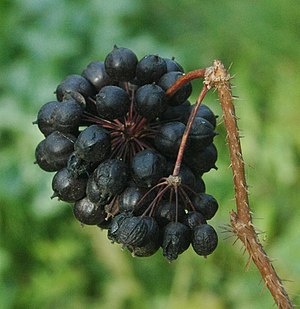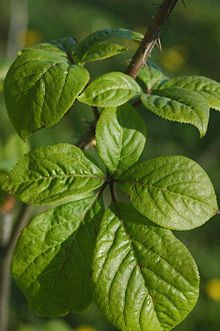Bristly taiga root
| Bristly taiga root | ||||||||||||
|---|---|---|---|---|---|---|---|---|---|---|---|---|

Bristly taiga root ( Eleutherococcus senticosus ), fruits |
||||||||||||
| Systematics | ||||||||||||
|
||||||||||||
| Scientific name | ||||||||||||
| Eleutherococcus senticosus | ||||||||||||
| ( Rupr. & Maxim. ) Maxim. |
The Siberian Ginseng ( Eleutherococcus senticosus , Syn. : Hedera senticosa .. Rupr & Maxim (Basionym), Acanthopanax senticosus . (Rupr & Maxim) Harms. ), Also briefly Siberian ginseng , devil bush , Stachelpanax , Siberian ginseng , Eleutherococcus called, is a flowering plant from the family of the Araliaceae .
Occurrence
The bristle taiga root is native to Siberia , in the Amur region , on the island of Sakhalin , in Japan (on the island of Hokkaidō ), North Korea , in the north-eastern People's Republic of China (in the provinces: Hebei , Shanxi , and in Manchuria , these are the provinces Heilongjiang , Jilin and Liaoning ).
description
The bristle taiga root is a deciduous shrub that can grow to heights of 2 to a maximum of 7 meters. It is only slightly branched and its branches have small spines. The long-stalked leaves are divided into hands ; the stalked leaflets are oval and serrated .
There are Doldige inflorescences formed. The small, radially symmetrical , hermaphrodite flowers are yellow. The aromatic fruits are blue to black. The species blooms in July and is pollinated by insects.
The number of chromosomes is 2n = 48.
use
The (dried) leaves are used to brew tea. The root of the plant (Radix Eleutherococci) is used as a drug .
ingredients
A multi-substance mixture called eleutheroside, which contains the following broken down substances: lignans such as eleutheroside B4 (sesamin) and eleutheroside E (liriodendrin); Phenylpropanoids such as coniferin and eleutheroside B (syringin or chlorogenic acid); Coumarins such as eleutheroside B1 (Isofraxidin); Triterpene saponins , identified as Eleutheroside I to M, as well as the sterol Eleutheroside A (β-Sisterol) and neutral glucans (Eleutheroside C - oligosaccharides ); β-carotene , vanillin , and vitamin E .
effect
The taiga root is considered to tone , stimulate , stimulate the immune system , have an antiviral effect and lower blood sugar . It is used as an adaptogenic medicinal plant.
research
According to Russian research in the 1950s, it is said to improve endurance , concentration , adaptability and resistance. The performance-enhancing effect of the drug has been demonstrated both in humans and in animal experiments. The anti-fatigue effect could also be partially confirmed.
literature
- Andrew Chevallier: The Great Lexicon of Medicinal Plants. Dorling Kindersley, Starnberg 2001, ISBN 3-8310-0167-7 .
Web links
- Profile of Art
- The way at GRIN
- The way in Plants for a Future (english)
- The species as a medicinal plant at AWL.ch
Individual evidence
- ↑ Eleutherococcus senticosus at Tropicos.org. In: IPCN Chromosome Reports . Missouri Botanical Garden, St. Louis
- ↑ : Monograph. Eleutherococcus senticosus. In: Alternative Medicine Review . Volume 11, Number 2, June 2006, pp. 151-155, ISSN 1089-5159 . PMID 16813463 .
- ↑ B. Glatthaar-Saalmüller, F. Sacher, A. Esperester: Antiviral activity of an extract derived from roots of Eleutherococcus senticosus. In: Antiviral Research . Volume 50, Number 3, June 2001, pp. 223-228, ISSN 0166-3542 . PMID 11397509 .
- ↑ K. Asano, T. Takahashi, M. Miyashita, A. Matsuzaka, S. Muramatsu, M. Kuboyama, H. Kugo, J. Imai: Effect of Eleutherococcus senticosus extract on human physical working capacity. In: Planta Medica . Number 3, June 1986, pp. 175-177, ISSN 0032-0943 . PMID 3749339 .
- ↑ J. Kuo, KW Chen, IS Cheng, PH Tsai, YJ Lu, NY Lee: The effect of eight weeks of supplementation with Eleutherococcus senticosus on endurance capacity and metabolism in human. In: The Chinese journal of physiology. Volume 53, Number 2, April 2010, pp. 105-111, ISSN 0304-4920 . PMID 21793317 .
- ^ Y. Kimura, M. Sumiyoshi: Effects of various Eleutherococcus senticosus cortex on swimming time, natural killer activity and corticosterone level in forced swimming stressed mice. In: Journal of Ethnopharmacology . Volume 95, Number 2-3, December 2004, pp. 447-453, ISSN 0378-8741 . doi: 10.1016 / j.jep.2004.08.027 . PMID 15507373 .
- ^ AJ Hartz, S. Bentler, R. Noyes, J. Hoehns, C. Logemann, S. Sinift, Y. Butani, W. Wang, K. Brake, M. Ernst, H. Kautzman: Randomized controlled trial of Siberian ginseng for chronic fatigue. In: Psychological medicine. Volume 34, Number 1, January 2004, pp. 51-61, ISSN 0033-2917 . PMID 14971626 .
